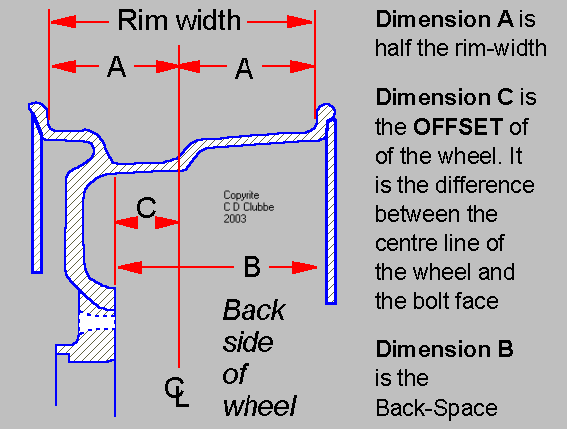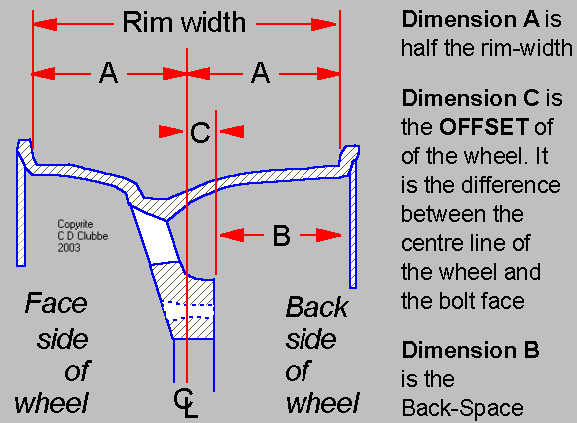Guide to Alloy Wheels
Manufacture and Use
Aluminium alloy wheels are made from a mixture of aluminium and silicon and other elements: blended to exact proportions for maximum strength. The most usual specification is LM9, but other mixtures are possible to give different characteristics for different requirements. The foundries have a spectrometer to test for the exact composition before casting the wheels. See below for technical details
Aluminium is a very reactive metal which easily corrodes (to aluminium oxide, a white powder) if not protected from air and water.
Even lighter wheels can be made by casting from a mainly Magnesium alloy, but they are very expensive and only used for racing applications. We cannot supply magnesium based wheels.
Most alloy wheels are made by casting in a mould to produce a complete wheel, but some are made in 2 pieces – the rim edge and the spokes are then bolted together, and some are made in 3 pieces – the centre spokes, the front of the rim, and the back of the rim. This means wheels can be made more easily in different widths to fit wider tyres: mostly applicable to racing requirements but also for high performance cars where it is not economic to make a mould for a just a few wide wheels.
After the wheels have been cast they have to be turned on a computer controlled lathe to get the diameter to the exact size then drilled with the bolt holes in the correct positions. The face of the wheel usually also requires some hand finishing to remove any imperfections from the mould.
It is also possible to machine alloy wheels directly from a single billet of alloy for low volume requirements where mass production techniques are not viable.
There are 2 main reasons for fitting Alloy Wheels: Weight and Style. Alloy wheels are lighter than the same size of steel wheel, so the unsprung weight of the car is reduced. They also look 10 times smarter than a steel wheel, even with a fancy plastic trim covering it.
Using modern alloy casting techniques it is possible to create quite exotic shapes and styles of wheel, whilst still retaining adequate strength.
Aluminium alloy is a semi-porous material. The wheels are pressure tested for leaks after drilling and turning but before painting.
Originally alloy wheels were produced with a polished finish and no paint to protect the alloy from corrosion. Then it became normal to supply alloy wheels with a silver painted finish, and in some variations with a diamond polished rim edge protected by lacquer. Advancing from this some highly reflective paint finishes were used to replicate the original polished finish.
The design of the latest styles of alloy wheels includes spokes with a twist or bend in them, spokes on 2 layers with the inner layer black and the outer layer polished, and coloured inserts in the spokes.
Current alloy wheel styles have moved on to include all black finishes, highly polished stainless steel rim edges, coloured red or blue or yellow bands around the rim edges, and various other combinations.
It is also possible to produce alloy wheels with a full metallic chrome plated finish. When new and properly plated the finish is superb but our experience of this finish is that it is very susceptible to weather related damage. It is essential that brake dust, which contains fine iron particles, is properly and regularly cleaned from the surface or a galvanic electro current can be set up due to the dissimilar metals effect between the aluminium in the wheel, the steel in the vehicle hub, the brake dust on the surface and the chrome in the plating. This causes the aluminium to oxidise and the chrome plate to lift. The process is aggravated by salt used on the roads during the Winter. It is recommended that chrome plated alloy wheels are used during the Summer months only and kept clean and dry.
No matter what style of alloy wheels you have or what finish it is essential to keep them clean and polished with the correct medium because once corrosion attacks alloy wheels it is impossible to stop it. For most wheels you need ordinary car wax, the same as you use on the main body of the car. If you have wheels without any paint or lacquer, or just a diamond polished rim edge, then Alusol should be used to keep the bright aluminium finish, but this needs doing weekly.
The style of alloy wheel to choose is actually the most difficult decision to make. So much depends on your personal choice: though it is also related to the other factors such as size of the wheels and available vehicle fitments, and of course cost.
A lot of cars are now fitted with alloy wheels as standard but many people choose to replace them either through personal choice or to fit bigger diameter wheels with a lower profile tyre. The reason for doing this is to improve the cars handling – a tyre with a smaller sidewall will flex less when cornering so improving the feedback through the steering wheel: and of course a bigger alloy wheel looks more impressive.
Alloy wheels are made in different strengths for different requirement: very light but strong for race cars, normal weight and strength for most road cars, and extra strength but heavier for commercial vehicles.
Using alloy wheels it is also possible to fit a greater range of wheel sizes and tyre diameters – so if your car has 195.65.15 tyres fitted as standard you can change to a bigger wheel with a lower profile tyre:
16″ wheels with 205.55.16 tyres
17″ wheels with 225.45.17 tyres
18″ wheels with 225.40.18 tyres
19″ wheels with 235.35.19 tyres
There are many other possibilities.
Many of the lower price alloy wheels are now made in the Far East where production costs are lower. This does not mean they are inferior quality: many of the major UK names such as Wolfrace and Momo have their alloy wheels manufactured abroad to the same standards as European made wheels.
There are a range of different vehicle fitments in use: the number of fixing bolts or studs varies from 3 to 6, the distance between the studs varies, and the diameter of the centre bore in the wheel varies between different makes of cars, and the offset of the wheel: which is the amount by which the wheel fits into the wheel arch relative to the vehicle hub must be correct for the car.
Most after-market alloy wheels can be supplied in these different fitments but it is essential that the car make, model, version and year are correctly specified when ordering. You should also check that a wheel fits correctly on the hub before fitting any tyres, and that you have the correct bolts or nuts to secure the wheel. After fitting new alloys, recheck the torque of the fixings after about 100 miles of driving.
Before bolting alloy wheels to the vehicle hub a light smear of copper grease should be used where the alloy will come into contact with the steel hub: otherwise corrosion between the dissimilar metals of the steel hub and the alloy wheel can cause the wheel to seize on to the hub. This applies both to new vehicle with manufacturers alloy wheels fitted as well as aftermarket wheels. (We once had a nearly new Landrover Freelander in the depot that had spent a few months standing before initial delivery and the alloy wheels could not be removed even hitting them with a sledge hammer.)
Most aftermarket alloys will be supplied with new wheel nuts or bolts because the original fixings may not suit the bolt hole of the new wheels: this applies to about 50% of vehicles where the manufacturer uses nuts or bolts with sometimes a flat collar or a radius seat or an extended washer.
Alloy wheels are often a target for thieves. They can be protected with locking wheel nuts or bolts which have a unique head that will not accept a conventional hex socket but an adaptor nut is also supplied for normal removal.
Be vary careful if buying second hand alloy wheels from Ebay or other sources. The face of the wheels may look good but they might be buckled, cracked, flat-spotted, or the bolt holes might be elongated. I have seen all these faults with second hand alloys. I have also come across wheels sold by private sellers which do not fit the car they were supplied for.
Because alloy wheels can corrode more easily than steel wheels, this can often be a source of irritation when corrosion between the wheel and tyre causes the tyre to lose pressure. The simple answer is that the corrosion can be cleaned away but the only long term solution is to get the wheels refurbished. If done properly and professionally the tyre will be removed, the whole wheel stripped down to bare metal, the face of the wheel skimmed on a lathe to remove any curbing marks or other imperfections, repairs to the wheel can be done at this time (e.g. flat spots removed), then painted with primer, paint and lacquer to original factory standards.
If you damage an original equipment alloy wheel, and it cannot be repaired, you have to buy a replacement from the franchised vehicle dealer.
It is normal to advise your Insurance Company if you fit alloys wheels as replacements for the original steel wheels, or bigger diameter wheels then standard.
ALLOY SPECIFICATIONS
There are 2 types of aluminium alloy in general use for casting alloy wheels:
Type LM9 is normally used for Low Pressure Die Casting, where the alloy is forced up into the mould by compressed air.
Type LM25 is normally used for Gravity Die Casting, where subsequent heat treatment is required to strengthen the alloy.
The range of specifications are:
Al
Cu
FE
Li
Mg
Mn
Pb
Si
Ti
Zn
~ 87.5%
0.2% max
0.45% max
0.01% max
0.25/0.45%
0.30% max
0.05% max
10/12%
0.20/0.40%
0.10/0.16%
0.10% max
~ 91.5%
0.2% max
0.35% max
0.01% max
0.25/0.45%
0.30% max
0.05% max
6/8%
0.20/0.40% max
0.10/0.16%
0.10% max
Alloy wheels are currently available in diameters from 12″ to 24″, and widths from 5″ upto 10″, depending on the application they are required for.
Typical wheel size designations are 7J17 or 6.5J15 or other combinations of numbers and letters.
In these cases the 7 or 6.5 refers to to the width of the rim where the tyre fits measured in inches between the rim flanges.
The 17 or 15 refers to the diameter of the wheel and again measured in inches.
The letter J specifies the height of the rim edges above the bead seating area. J is the normal designation for many modern car wheels, but other letters are possible as shown in this table.
Height of Wheel Rim Flanges
Letter Inches mm
J 0.68 17.3
JK 0.71 18.0
K 0.77 19.6
L 0.85 21.6
It is quite normal to alter the size of wheel when fitting alloys. Most cars are fitted with 13″ or 14″ steel wheels. When changing to alloys – you can replace with the same size of wheel, and keep the same size tyre, or move up to 14″, 15″, or even 16″ or 17″ wheels.
I first wrote this page some years ago. Things have now moved on to the point where most cars have 16″ wheels as standard, where 17″ and 18″ wheels are optional extras, and 19″ or 20″ are not unusual.
The larger the wheel and the smaller the tyre profile the more impact the wheel chosen will have on the overall look of the car. The important thing is to keep the same overall tyre diameter. This is done by using a lower profile tyre.
Vehicle Fitment
This is where things get a bit more technical. Most of the wheels shown on this web site are available to fit most cars – we can order them with different bolt centres and different offsets to suit different cars.
You don’t need to know what the technical dimensions of your wheels are, because we will supply wheels with the correct fitment, but for reference the illustration below shows the important dimensions.
PCD and OFFSET
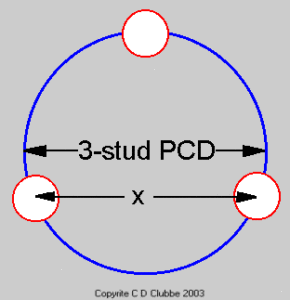 |
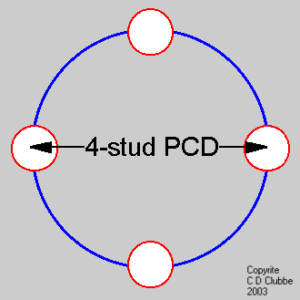 |
|||||||
|---|---|---|---|---|---|---|---|---|
| 3 HOLE WHEELS Measure the distance X between the centres of 2 holes and multiply by 1.154 |
4 HOLE WHEELS Measure the distance between the centres of 2 OPPOSITE holes OR Measure the distance between the centres of 2 ADJACENT holes and multiply by 1.414 |
|||||||
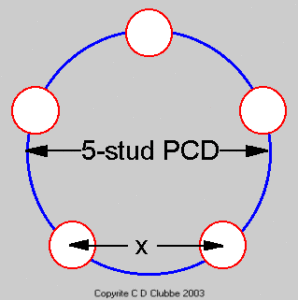 |
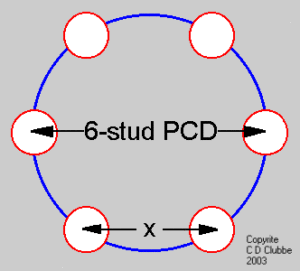 |
|||||||
| 5 HOLE WHEELS Measure the distance X between the centres of 2 ADJACENT holes and multiply by 1.7012 |
6 HOLE WHEELS Measure the distance between the centres of 2 OPPOSITE holes OR Measure the distance X between the centres of 2 adjacent holes and multiply by 2 |
|||||||
| PCD stands for Pitch Circle Diameter
OFFSET is often referred to as ET which standsfor EinpressTieffe in German |
||||||||
|
||||||||
| OFFSET = BACKSPACE – ½(RIM WIDTH) or C = B – A |
||||||||
|
||||||||

